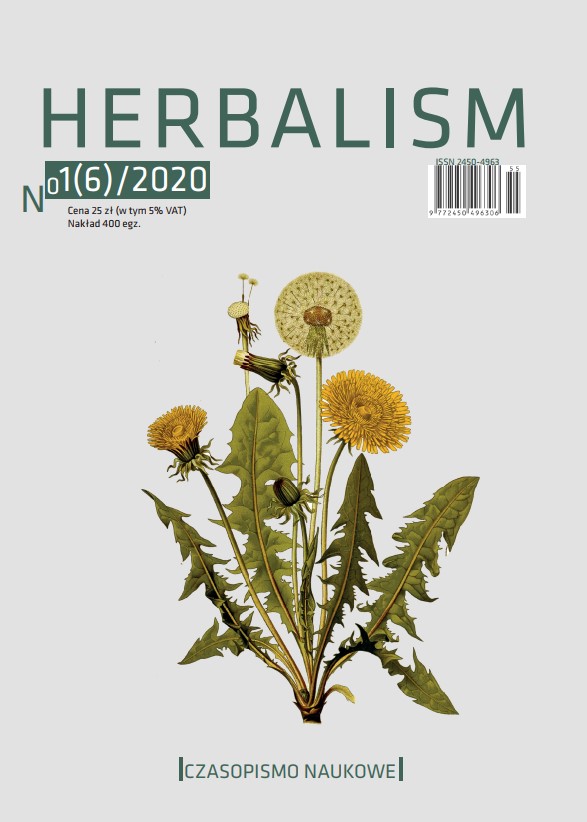Rośliny poświęcone świętym i ich zastosowanie
DOI:
https://doi.org/10.12775/HERB.2020.013Resumen
Niezależnie od religii uważa się, że rośliny są święte, stworzone przez Boga i są darem dla ludzi. Zarówno w czasach pogańskich, jak i w katolickich rytuałach rośliny służyły do uzyskania przychylności bogów i duchów. Uważano je za skuteczny środek nie tylko przeciw chorobom, ale też urokom, czarom, duchom, demonom oraz nieszczęściom zsyłanym przez złe moce. Kilku gatunkom drzew, np. lipie przypisywano szczególną moc. Wiele z roślin wykorzystywanych w ludowej medycynie nosiło nazwy związane z imieniem Matki Boskiej. Nazewnictwo to najczęściej wynikało ze skojarzenia wyglądu rośliny lub ich części z ubiorem Matki Boskiej, jej przymiotami,
narzędziami, których mogła używać, cierpieniem. Nazwy wielu roślin poświęcono też różnym świętym, np. św. Janowi, Piotrowi, Benedyktowi, Ignacemu. Niestety, nazwy ludowe i gwarowe roślin odchodzą w zapomnienie i giną bezpowrotnie. Fenomenem jest to, że nazwy roślin z imionami świętych zachowały się w nazewnictwie angielskim i niemieckim wielu roślin leczniczych i stosowane są zarówno w literaturze naukowej, jak i w potocznym języku.
Citas
Leńkowa A., Oskalpowana Ziemia, PAN, Kraków, 1961.
Kozłowski J. i wsp., Rośliny w Piśmie świętym, Panacea, 2007, 18(1), s. 28–31.
Jagla J., Symboliczny język roślin i ziół w przedstawieniach Chrystusa, Panacea, 2009, 27(2), s. 30–33.
Lech-Kirstein D., Nazwy ziół w polskiej toponimii, Uniwersytet Opolski, 2012, s. 157–167.
Szot‐Radziszewska E., Sekrety ziół: wiedza ludowa, magia, obrzędy, leczenie, Trio, 2005.
Trzos P. Wpływ kultury chrześcijańskiej na nazewnictwo roślin leczniczych, Farmacja Polska, 2003, 59(10), s. 466–470.
Rak M., Kwiatki Matki Boskiej. Góralskie fitonimy motywowane imionami świętych i Matki Bożej, [w:] Andrzej Jackowski, Iwona Hodorowicz, Franciszek Mróz (red.), Turystyka religijna w obszarach górskich, Nowy Targ, 2009, s. 447–457.
Rak M., O pochodzeniu góralskich fitonimów, [w:] Komorowska E, Stanulewicz D. (red.), Język, kultura i świat roślin. Księga pamiątkowa ofiarowana Profesor Halinie Chodurskiej, Szczecin, 2010, s. 224–232.
Matławska I., Rośliny poświęcone świętym, Biuletyn Stowarzyszenia Farmaceutów Katolickich Polski, 2014, 1(45), s. 103–108.
Schmidt M., Galium verum aqueous extract strongly inhibits the motility of head and neck cancer cell lines and protects mucosal keratinocytes against toxic DNA damage, Oncol Rep., 2014, 32(3), s. 1296–302.
Schmidt M., E{ect of Galium verum aqueous extract on growth, motility and gene expression in drug-sensitive and -resistant laryngeal carcinoma cell lines, Int J Oncol., 2014, 44(3), s. 745–60.
Lysiuk R. i Darmohray R., Pharmacology and Ethnomedicine of the Genus Astragalus, International Journal of Pharmacology, Phytochemistry and Ethnomedicine, 2016, 3, s. 46–53.
Vrchovská V. i wsp., Assessing the antioxidative properties and chemical composition of Linaria vulgaris infusion, Nat Prod Res., 2008, 22(9), s. 735–46.
Piotrowska P. i wsp., Podbiał pospolity (Tussilago farfara L.), Postępy Fitoterapii, 2015,
, s. 157–171.
Martucciello S., Steroids from Helleborus caucasicus reduce cancer cell viability indu-cing apoptosis and GRP78 down-regulation, Chemico-Biological Interactions, 2018, 279, s. 43–50.
Łysiak-Seichter M. i Łysiak M., Święta Apolonia – patronka dentystów, Czas. Stomatol., 2006, LIX, 4, s. 285–288.
Marzotto M. i wsp., E{ects of Ignatia amara in mouse behavioural models, Homeopathy, 2012, 101(01), s. 57–67.
Knuesel O. i wsp., Arnica montana gel in osteoarthritis of the knee: An open, multi-center clinical trial, Adv. er., 2002, 19(5), s. 209–218.
Descargas
The publisher's shop:
Publicado
Cómo citar
Número
Sección
Licencia

Esta obra está bajo una licencia internacional Creative Commons Atribución-SinDerivadas 4.0.
Stats
Number of views and downloads: 650
Number of citations: 0



